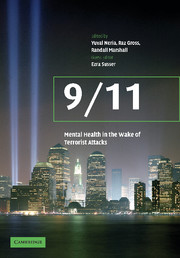Book contents
- Frontmatter
- Contents
- Acknowledgments
- Editors brief bio
- List of contributors
- Foreword
- Part I Introduction
- Part II The psychological aftermath of 9/11
- Part III Reducing the burden: community response and community recovery
- 9 Community and ecological approaches to understanding and alleviating postdisaster distress
- 10 What is collective recovery?
- 11 Rebuilding communities post-disaster in New York
- 12 Journalism and the public during catastrophes
- 13 Effective leadership in extreme crisis
- 14 Guiding community intervention following terrorist attack
- Part IV Outreach and intervention in the wake of terrorist attacks
- Part IV A New York area
- Part IV B Washington, DC
- Part IV C Prolonged-exposure treatment as a core resource for clinicians in the community: dissemination of trauma knowledge post-disaster
- Part V Disasters and mental health: perspectives on response and preparedness
- Index
10 - What is collective recovery?
from Part III - Reducing the burden: community response and community recovery
Published online by Cambridge University Press: 27 October 2009
- Frontmatter
- Contents
- Acknowledgments
- Editors brief bio
- List of contributors
- Foreword
- Part I Introduction
- Part II The psychological aftermath of 9/11
- Part III Reducing the burden: community response and community recovery
- 9 Community and ecological approaches to understanding and alleviating postdisaster distress
- 10 What is collective recovery?
- 11 Rebuilding communities post-disaster in New York
- 12 Journalism and the public during catastrophes
- 13 Effective leadership in extreme crisis
- 14 Guiding community intervention following terrorist attack
- Part IV Outreach and intervention in the wake of terrorist attacks
- Part IV A New York area
- Part IV B Washington, DC
- Part IV C Prolonged-exposure treatment as a core resource for clinicians in the community: dissemination of trauma knowledge post-disaster
- Part V Disasters and mental health: perspectives on response and preparedness
- Index
Summary
George Engel, in his classic article on the biopsychosocial model of psychiatry, argued that a patient's full recovery might depend on interventions in systems outside of the individual's body, such as in the family system, the hospital system or other social systems within which the individual is nested (Engel, 1980). He pointed out that these systems were organized hierarchically, with larger systems acting to constrain smaller systems, as, for example, the family can constrain the actions of the individual. At each level of the hierarchy, we find systems that are self-integrated. At the same time, each system is interconnected with other higher and lower order systems. Following on Engel's seminal work, it has become clear that individual health is formed by interactions among systems. Analysis of these systems – and the formulation of intervention – depends on the examination of each system, or level of scale, on its own merits and with regard to other systems in the hierarchy.
Large-scale disasters, such as the attacks on the World Trade Center of September 11, 2001, demand this kind of multi-level analysis and intervention. Although the individual is the unit of most interest to biomedical practitioners, the injury that results from disaster is not limited to the system of the individual. Larger social groups, such as the family and the neighborhood, are also injured by disaster and implicated in recovery. In fact, the solution to the problems of the individual may lie at a level of scale at some remove from the single person.
- Type
- Chapter
- Information
- 9/11: Mental Health in the Wake of Terrorist Attacks , pp. 157 - 163Publisher: Cambridge University PressPrint publication year: 2006
- 1
- Cited by



